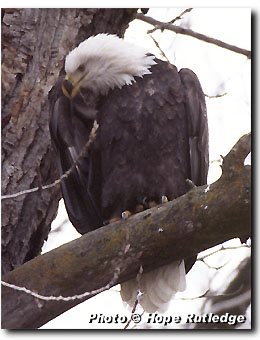 |
 |
| Bald eagles have 7,000 feathers. Eagle feathers are lightweight yet extremely strong, hollow yet highly flexible. They protect the bird from the cold as well as the heat of the sun, by trapping layers of air. To maintain its body temperature an eagle simply changes the position of its feathers. While an eagle suns itself on a cold morning, it ruffles and rotates its feathers so that the air pockets are either opened to the air or drawn together to reduce the insulating effect. Feathers also provide waterproofing and protection, and are crucial for flight. Feather structure makes pliability possible. Overlapping feathers can form a dense covering, which the birds can open or close at will. The bald eagle has several layers of feathers, each serving a different function. Under the outer layer of feathers is an inner layer of down or smaller feathers. The inter locking of feathers is an astonishing design of nature. The feathers enable eagles to live in extremely cold environments. Eagles do not have to migrate to warmer areas each year to fulfill temperature requirements, they migrate to available food supplies. A lone eagle feather is believed to convey great power. North American Indians incorporated the eagle's primaries and tail feathers into their ceremonies and legends. Respiratory system - Eagles have external nares opening on both sides of the bill. A bald eagle never reaches speeds that would interfere with normal breathing. The eagle's lungs and air sac system is adequate for its size. Air moves in through the lungs and on into the air sacs before moving back through the lungs and out again. Air passes through the lungs twice with each breathing cycle - twice that of mammals. |
| Beak - The hook at the tip is used for tearing. Behind the hook, the upper mandible, the edge sharp enough to slice tough skin, over laps the lower, creating a scissors effect. A bald eagle's beak is a strong weapon, but is also delicate enough to groom a mate's feathers or feed a small portion of food to a newly hatched chick. The beak and talons grow continuously, because they are made of keratin, the same substance as our hair and fingernails. The beak of a captive eagle is not warn down naturally, so must be trimmed annually. Talons - Talons are important tools for hunting and defense. Eagles kill their prey by penetrating its flesh with their talons. Above all other birds it is the soaring eagle, with its size and weight, that gives the most abiding impression of power and purpose in the air. It advances solidly like a great ship cleaving the swells and thrusting aside the smaller waves. It sails directly where lesser birds are rocked and tilted by the air currents. |
 |